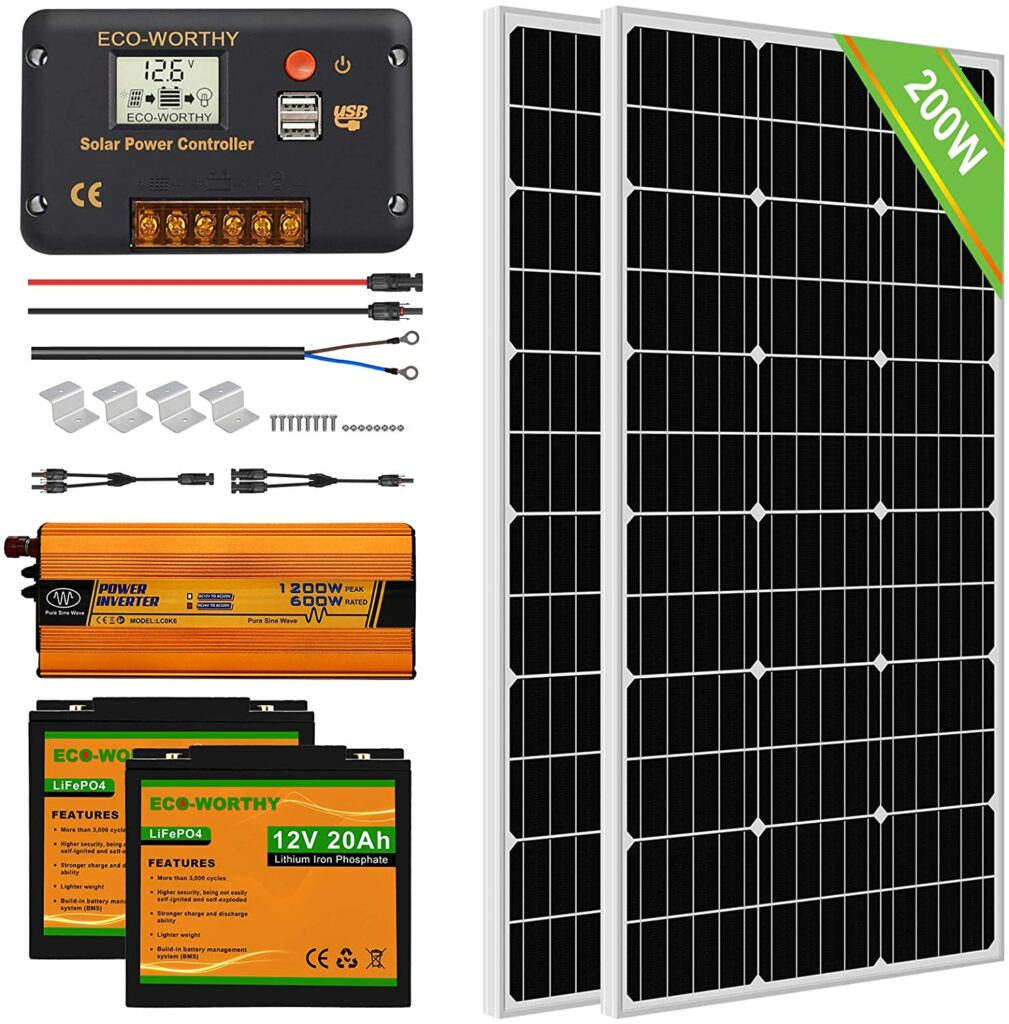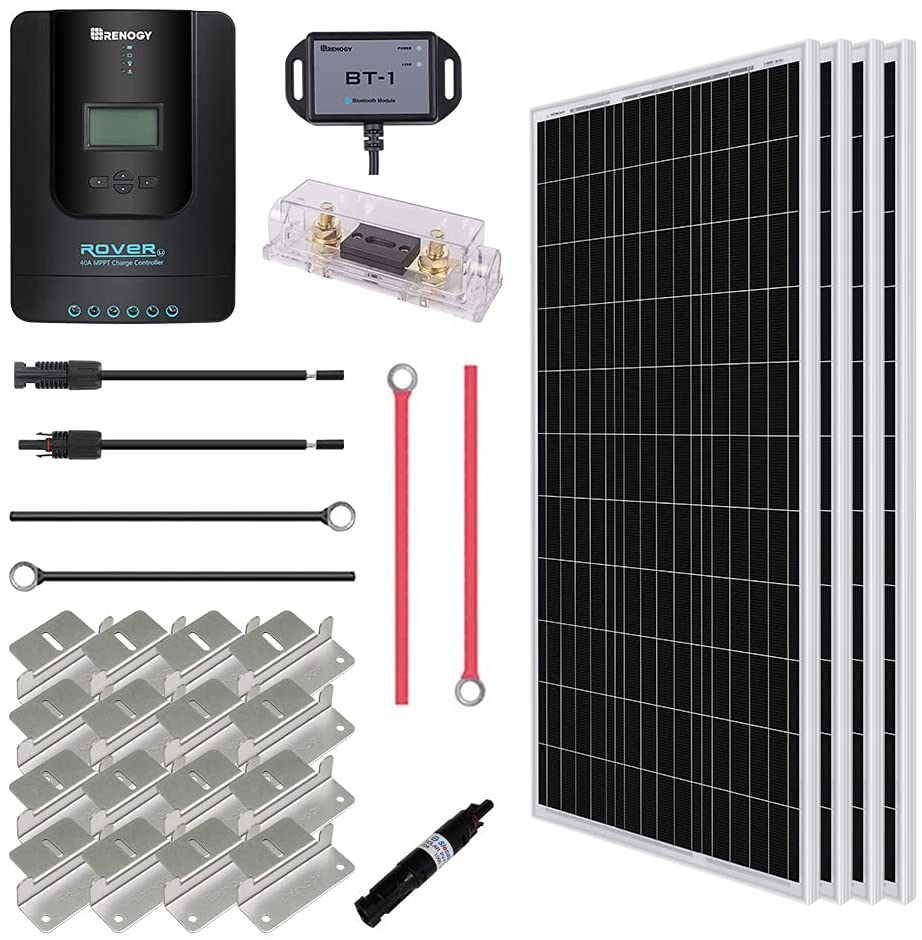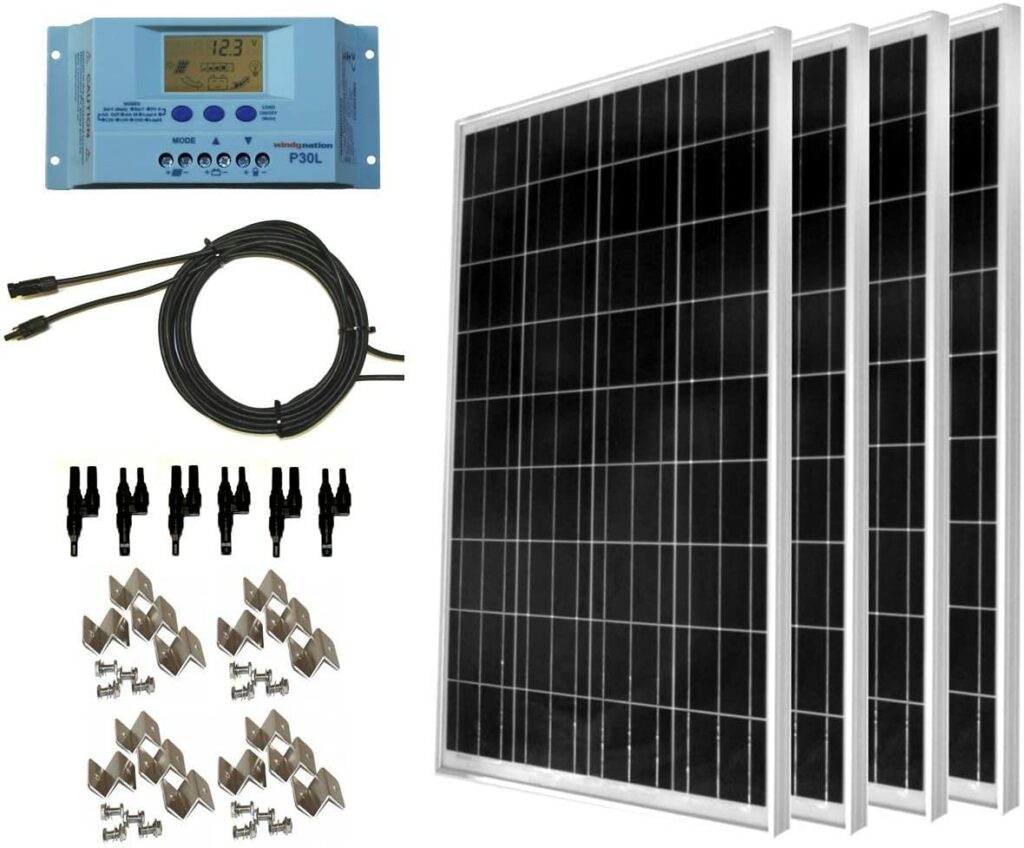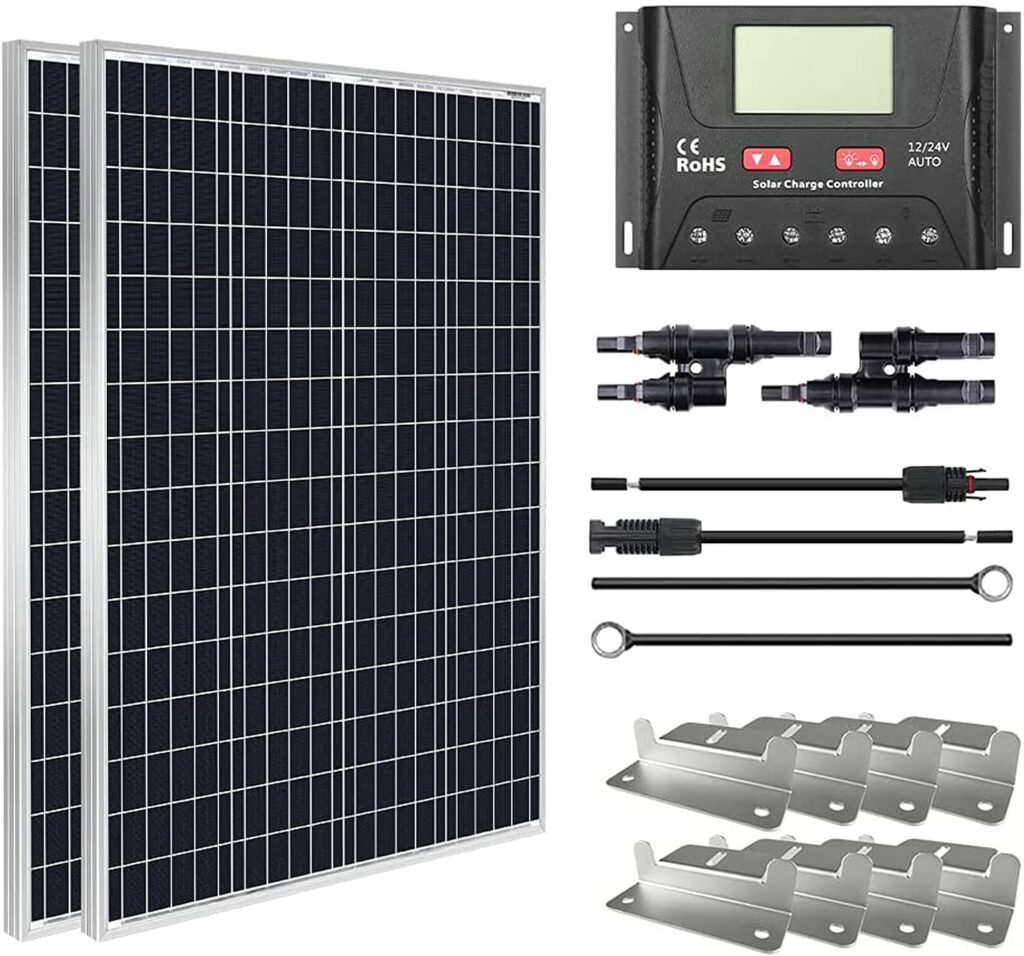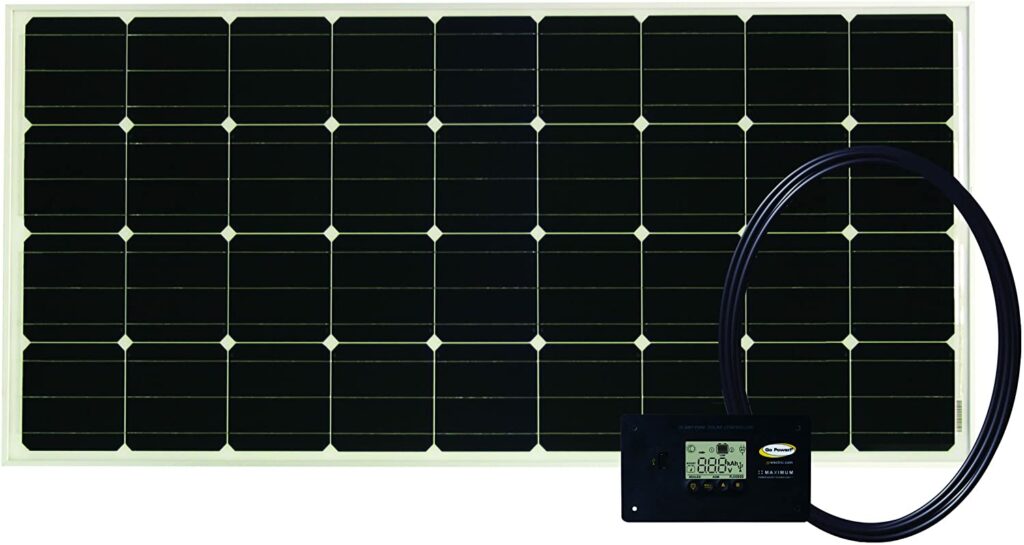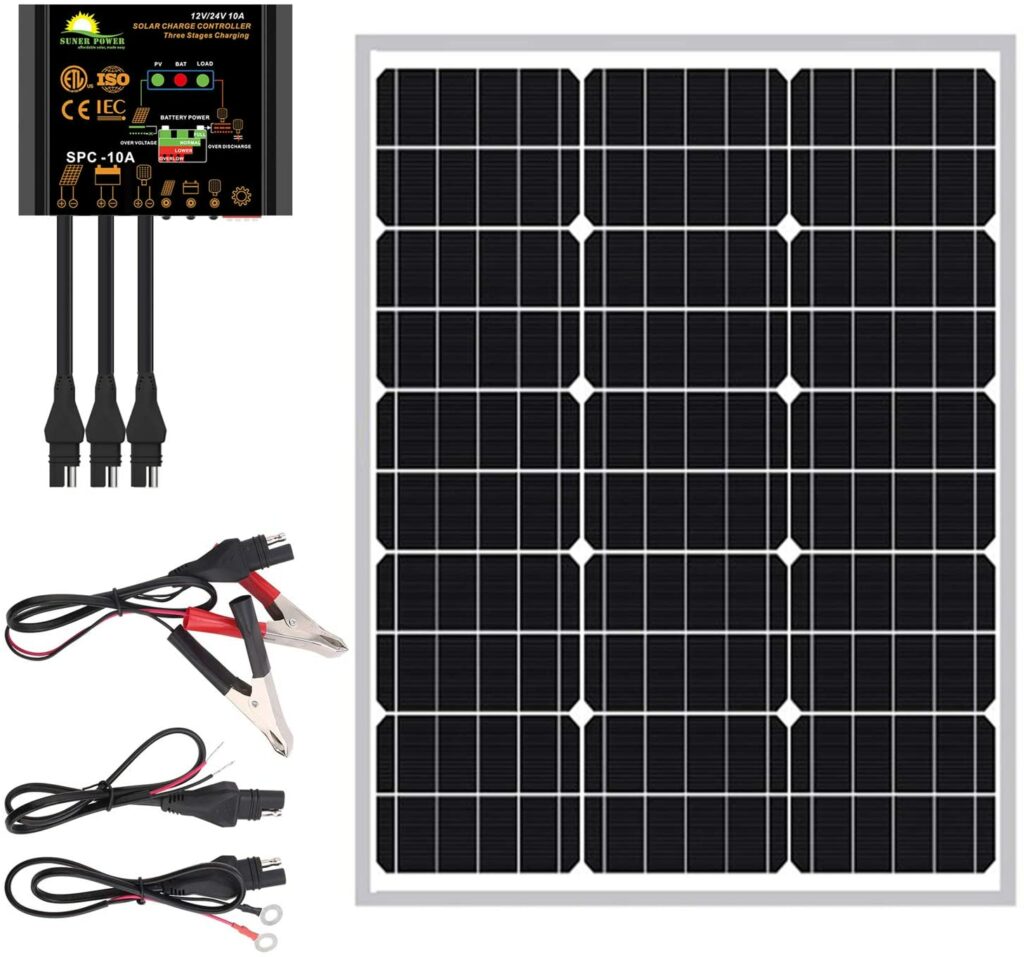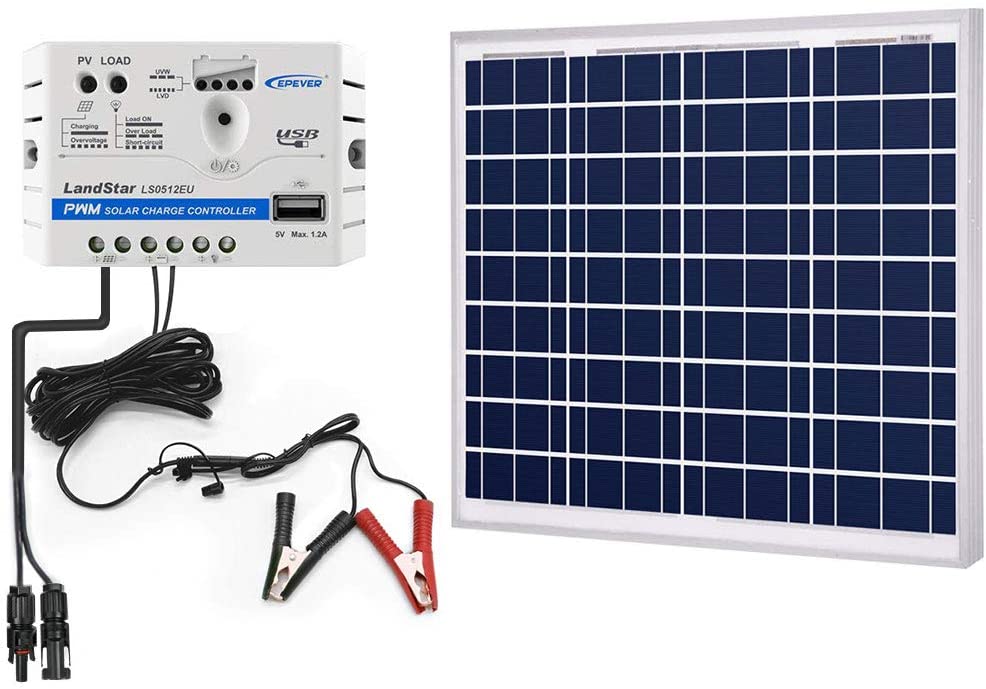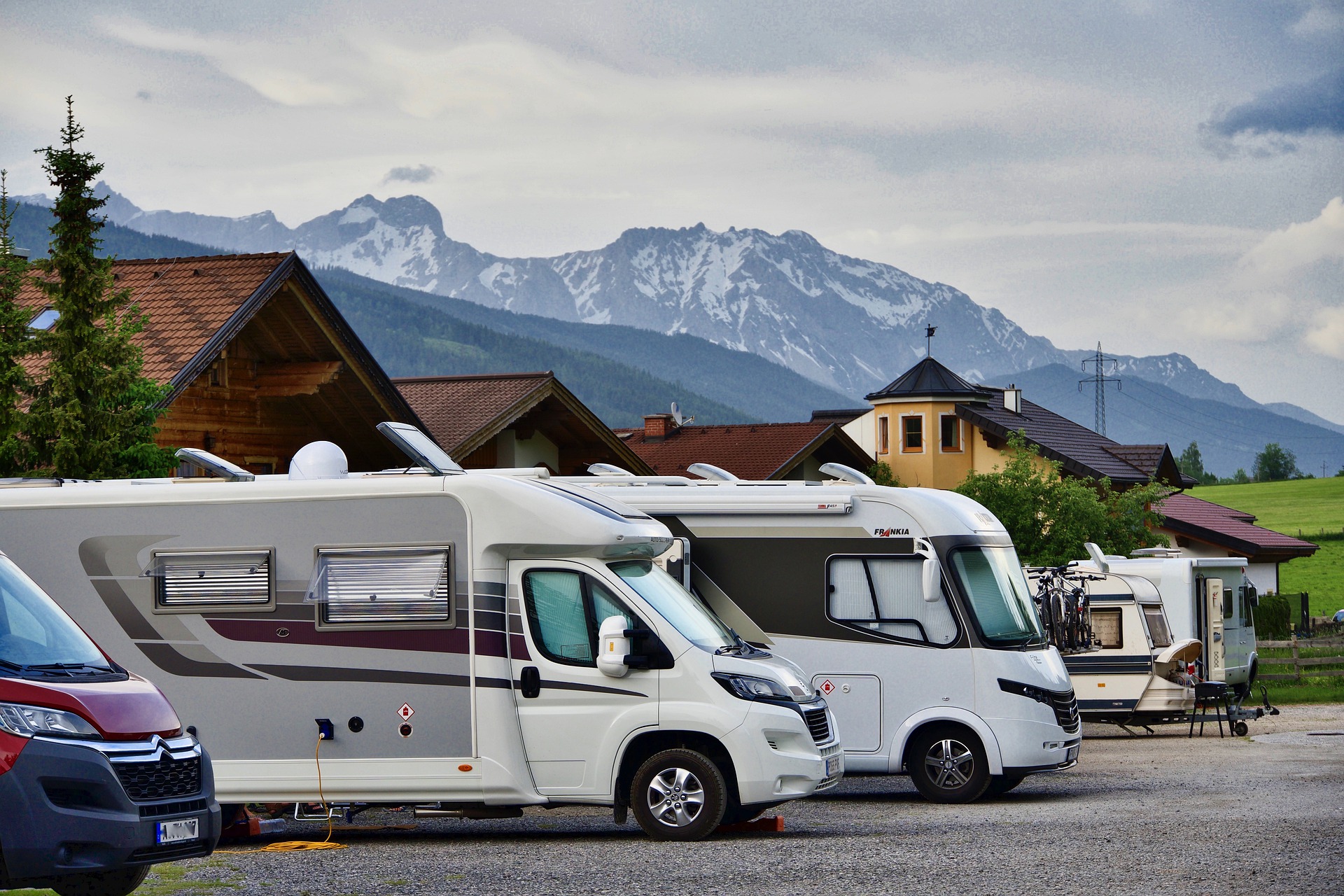
As an RVer, you live the challenges of finding unoccupied, non-faulty power hookups or places to fill up a stinky, fossil fuel-powered generator. What a hassle that searching can be.
Have you considered solar panels as an alternative energy solution to meet all your RV needs? Not only is it quieter — it’s also less polluting!
Solar power is right above you in the sky, following you wherever you go in your rig of choice: RV, motorhome, camper, trailer, or van. It’s literally waiting to be tapped for energy by you.
Also read:
- The 7 best flexible solar panels: Reviews and buyer’s guide (2021)
- What is the best angle for solar panels?
Full-time or seasonal RVers as well as weekend warriors can enjoy the benefits of renewable energy on the road.
It all starts with the best RV solar panels for off-grid fun.
Whether you’re boondocking in the middle of nowhere or enjoying outdoor life in a campsite close to home, hooking up one or more of the best RV solar panel kits showcased in our list will give you clean energy that you can feel good about — for yourself and the planet.
In this buyer’s guide, we’ll list our 7 top choices for the best RV solar panels and kits on the market today. Of course, necessary components for their functioning — like a charge controller, mounting brackets, and cabling – are included in the solar kits containing these superior solar modules.
Some of our picks come with solar inverters and batteries, too.
So wherever you are in terms of energy independence, our list of the 7 best RV solar panels and kits has got you covered.
Important information on the compatibility of these top choices of RV solar panels with various batteries, generators, and inverters is included in this article.
At the end, you’ll find an informative buyer’s guide to aid you in finding the optimal choice of an RV solar panel kit that will meet your specific needs — whatever type of off-grid adventurer you are.
If you’re curious about how we arrived at our list of the best RV solar modules, find details on the decision process in our previous article.
Full-time boondockers, RV newbies, and everyone in between can benefit from equipping their vehicle of choice with solar panels. Here are the best seven options in solar panel kits arranged by how complete or how much energy the systems produce.
Table of Contents
The 7 best RV solar panel kits: At a glance
- Best Complete Setup: ECO-WORTHY 200W 12V monocrystalline 2 pcs. + 30A charge controller + 2pcs 20Ah lithium battery + 600W inverter
- Best for Full-Time RVers: Renogy 400W 12V monocrystalline 4pcs 40A MTTP controller + hardware
- Best for Full-Time RVers Runner Up: WindyNation 400W polycrystalline 4 pcs 30A PWM controller + hardware
- Best for Seasonal RVers/Best Budget: HQST 2pcs 200W 12V/24V monocrystalline 30A PWM controller + hardware
- Best for Weekend RVers (minimal setup): Go Power! 1x 190W monocrystalline 30A PWM controller + hardware
- Best for RV Solar Newbies: Suner Power 50W 12V monocrystalline 10A controller + hardware
- Best for RV Solar Newbies Runner Up: Acopower 50W 12V polycrystalline 5A controller + hardware
Best complete setup: ECO-WORTHY 200W kit
To be completely honest, this package from Eco-worthy almost didn’t make the final cut.
We couldn’t find the efficiency rating for the modules anywhere. So, we emailed the company and waited.
Within an hour (and it was in the middle of the night on the East Coast), we got a reply from George!
He said: “Solar panel efficiency ratings measure the amount of sunlight captured by a solar panel. If a panel is rated at 18% efficiency, that means that 18% of the sunlight that hits the face of the panel will be converted into usable power. Most solar panels on the market have efficiency ratings that fall between 15-23%. ECO-WORTHY’s panels are between 18-20%.”
So there you have it.
Besides this excellent efficiency, we liked that the wattage is manageable enough for even newcomers to solar.
The pure sine wave (PSW) inverter, pulse width modulation (PWM) charge controller, and more efficient, longer-lasting lithium batteries will provide for 10 years (3,000 cycles) of environmentally-friendly power while you’re enjoying RV life on the open road.
For more spec details on this package, check out Eco-Worthy.
What we like about ECO-WORTHY 200W kit:
- Should be able to handle an electric coffee pot, mini-fridge, and TV at the same time
- Helpful video of the setup on Amazon
- Modules are rated for high winds and heavy snow loads
- Inverter will work with lead acid batteries
- Charge controller is suitable for sealed, gel, flooded, and lithium batteries
What we don’t like about ECO-WORTHY 200W 1kit:
- Won’t work with PV modules rated 400W+ in total unless you upgrade controller, inverter, and battery pack
Key ECO-WORTHY 200W kit:
- Solar Panel: 2x 100W monocrystalline, 18-20% efficiency
- Panel Weight & Dimensions: 14 lbs, 39.8 x 20.1 x 1.4 in.
- Charge Controller: 30A, PWM, P30L, protection from overload, short circuit, reverse polarity, and battery overheat
- Battery: 2x 20AH lithium battery
- Average Output: 800Wh/day
- Included: 2x 100Watt solar panel, 30A PWM solar charger controller, 600W solar PSW inverter, 2x 20AH lithium battery, 1 pr solar cable & Y-branch connector, 1 pr controller-to-battery cable, 1 pr battery-to-battery cable, 4-Z brackets
- Warranty: 5-yr/95%, 10-yr/90%, 25-yr/80%; 2-yr limited material, workmanship
- Price: $546
Best for full-time RVers: Renogy 400W 12V kit
Renogy is a trusted name among solar-powered RVers with good reason. Quality products and high levels of customer satisfaction coupled with exceptional service and support mean Renogy unquestionably merits a top spot in our list of the best RV solar panels and kits.
This particular Renogy package comes with enough wattage to provide you with up to 1,800 Wh or 160 Ah per day. We’re talking about recharging batteries to run a large number of devices with ease!
This MTTP controller is more efficient than PWM devices by 30%, so rest assured you’re getting the most power the modules can deliver. It delivers 98% conversion efficiency and 99% tracking efficiency. And it’s compatible with 12V and 24V panels.
The controller offers protection from overload, overcharging, short circuit and reverse polarity. It can charge sealed, gel, and flooded batteries.
The junction box and inline fuse are waterproof (IP65 rated).
What we like about Renogy 400W kit:
- Pre-drilled holes on the back for easier mounting
- Works great on irregular surfaces
- Bluetooth module can be coupled with the Renogy DC Home App
What we don’t like about Renogy 400W kit:
- For parallel attachment, a MC4Y connector is needed (not included)
- No cable entry housing is included
Key Renogy 400W kit specs:
- Solar Panels: monocrystalline, 21% efficiency
- Panel Weight & Dimensions: 3 lbs., 42.2 x 19.6 x 1.38 in.
- Charge Controller: 40A MTTP
- Battery: not included
- Average Output: 1,800 Wh or 160 Ah per day
- Included: 4x 100W 12V monocrystalline PV modules, one 40A MPPT Rover charge controller, one 20ft 10AWG MC4 adaptor kit, one 8ft 8AWG tray cable, four sets of Z-brackets, 1 10A inline fuse, 1 40A ANL fuse
- Warranty: 25-year power output: 5 year/95%//10 year/90%// 25-year/80%; 5-year material and workmanship
- Price: $800
Best for full-time RVers runner-up: Windy Nation 400W kit
As a long-time favorite of RVers, Windy Nation should surprise no one for earning a top 3 spot on our list of the best RV solar panels.
This solar kit will power up most of your devices and appliances with ease on sunny days. Attaching battery storage or a solar generator will keep you comfortable at other times, too.
Windy Nation loses a few points in our book because they do not appear to offer on their website monocrystalline modules in their kits (although you could certainly DIY it with their mono panels).
What we like about Windy Nation 400W kit:
- Battery temperature sensor (BTS) included in the controller
- Controller user manual and wiring diagrams on company website
What we don’t like about Windy Nation 400W kit:
- Need to cut cable length to fit your particular setup
Key Windy Nation 400W kit specs:
- Solar Panel: 4x 100W polycrystalline, 17% efficiency
- Panel Weight & Dimensions: 6 lbs, 40 x 26.4 x 1.2 in.
- Charge Controller: 30A, PWM, P30L, protection from overload, short circuit, reverse polarity, and battery overheat
- Battery: not included
- Average Output: 1600Wh/day
- Included: 4x 100W polycrystalline solar panels, 30A solar charge controller, 40 ft 12AWG solar cable, cabling connectors, mounting hardware (16 solar panel mounting bracket and fastener sets)
- Warranty: 5 yr solar panels, 25 yr power output, 1 yr on all other included components
- Price: $550
Best for seasonal RVers/best budget: HQST 2pcs 200W kit
Coming in at #4 on our list of the 7 best RV solar panels is a basic solar package by HQST, perfect for folks who are casual or seasonal about their road trekking. However, even a 200W RV solar panel system will cover most of your electrical must-haves effortlessly.
HQST also sells this kit with polycrystalline panels at apparently the same price (at least at the time of this writing). So, of course, we opted for the more efficient PV modules!
With waterproof, IP65 rated junction box and IP67 MC4 connectors as well as a drainage hole, this kit is also ideal for RVers spending a lot of time in rainy weather.
We were impressed with the speedy email response from HQST about their module efficiency: 15%!
What we like about HQST 2pcs 200W kit:
- Bypass diodes minimize power drop in shade, low-light
- Pre-drilled holes on modules
- Controller compatible with gel, flooded, sealed lead acid/AGM, lithium batteries
- Module is slightly more compact compared to other brands
- User manual at company website
What we don’t like about HQST 2pcs 200W kit:
- May need an extension cable (not included) to complete installation
- Some reviewers say panel packaging is minimal
Key HQST 2pcs 200W kit specs:
- Solar Panel: 2x 100W monocrystalline, 15% efficiency
- Panel Weight & Dimensions: 1 lbs, 40.1 x 20 x 1.18 in.
- Charge Controller: 30A, 12V/24V PWM, protection from overload, short circuit, reverse polarity, and battery overheat
- Battery: not included
- Average Output: 800Wh/day
- Included: 2x 100W 12 V monocrystalline solar panel, 30A 12V/24V PWM solar charge controller, 20ft 10AWG solar panel and controller connector cables, 2 pr Z brackets, 8ft 10AWG controller and battery connector cables
- Warranty: 5 yr/95%, 10 yr/90%, 25-yr/80%; 5 yr material and workmanship
- Price: $240
Best for weekend RVers (minimal setup): Go Power! 1x 190W kit
For folks who don’t like to dabble too much in the finer details of electrical circuitry and instead maximize their outdoor recreation, this Overlander solar panel kit is perfect for you.
Do you know it’s the largest single 12V solar kit you can buy today? If you’re limited on space but want a decent amount of power, the Overlander delivers.
Many trailer brands are prewired for the Overlander, simplifying solar even more for you. Just ask your dealer.
What we like about Go Power! 1x 190W kit:
- Ability to charge two battery banks
- USB port on controller is very convenient for quick charging of small electronics
What we don’t like about Go Power! 1x 190W kit:
- Several reviewers state the controller is not Bluetooth enabled
Key Go Power! 1x 190W kit specs:
- Solar Panel: 1x 190W monocrystalline, 21% efficiency
- Panel Weight & Dimensions: 4 lbs, 59.1 x 26.3 x 1.58 in.
- Charge Controller: 30A, PWM, P30L, protection from overload, short circuit, reverse polarity, and battery overheat
- Battery: not included
- Average Output: 800Wh/day
- Included: 1x 190W monocrystalline module, 30A dual-bank, Bluetooth PWM solar controller, 25ft MC4 output cable (red #10), 25ft MC4 output cable (black #10), 1x mounting hardware
- Warranty: 25 yr power output (module); 5 yr (controller)
- Price: $595
Best for RV solar newbies: Suner Power 50W kit
For people who aren’t too technically savvy, the plug and play set up of Suner Power’s RV solar newbie kit may be just what you need to get started with off-grid solar energy.
Since the controller and the junction box are waterproof, water won’t be much of a problem, either.
The kit features efficient monocrystalline panels, highly rated in strong winds, hail, and heavy snow, making them practically indestructible.
The waterproof controller in this kit is compatible with AGM, flooded, gel, and lead acid batteries.
With a 5-way adapter (not included) for the controller, you can add more panels for greater power output than what this basic package produces.
What we like about Suner Power 50W kit:
- IP65 rated junction box
- Plug and play SAE connectors
- Compatible with many different mounting bracket types
What we don’t like about Suner Power 50W kit:
- Connector extension cables not included
- Mounting brackets not included
Key Suner Power 50W kit specs:
- Solar Panel: 1x 50W monocrystalline, 18.5% efficiency
- Panel Weight & Dimensions: 7 lbs, 26.37 x 20.47 x 0.98 in.
- Charge Controller: 10A, PWM, protection from overload, short circuit, reverse polarity, and battery overheat
- Battery: not included
- Average Output: 200Wh/day
- Included: 1x 50Watt monocrystalline solar panel, 10A PWM solar charger controller, 3-piece SAE cable kits — battery clamps, battery rings and bare wire cable
- Warranty: power output: 10 yr 90%, 25 yr 80%, 1-yr for all components
- Price: $86
Best for RV solar newbies runner-up: Acopower 50W kit
For adventurous RVers just getting started with solar and wanting to keep it low-key, you can’t get much smaller than Acopower’s 50W RV solar panel kit.
For your convenience, the user manuals are available for download on the company website. A helpful (large and colorful!) wiring diagram is there, too.
Sealed, gel, and flooded batteries are compatible with the charge controller in this kit.
What we like about Acopower 50W kit:
- Pre-drilled holes
- USB port on controller
- Rated to withstand high winds and heavy snow loads
- SAE connector fits with pre-wired 2-pin socket in RV sidewall
- The Amazon page gives clear instructions (with diagram) on how to install this basic solar system as well as manuals, spec sheets, and certificates
What we don’t like about Acopower 50W kit:
- Mounting brackets not included
- Solar extension cable with MC4 connectors not included
Key Acopower 50W kit specs:
- Solar Panel: 1x 50W polycrystalline, 13.5% efficiency
- Panel Weight & Dimensions: 11 lbs, 26.4 x 21.7 x 1.4 in.
- Charge Controller: 30A, PWM, P30L, protection from overload, short circuit, reverse polarity, and battery overheat
- Battery: not included
- Average Output: 200Wh/day
- Included: 1x 50W 12V polycrystalline solar panel, 5A PWM charge controller, alligator clips and SAE connectors, 20ft cable (charge controller to battery)
- Warranty: 5 yr material and workmanship; 25 yr/85% power output
- Price: $90
Buyer’s guide for RV solar panels and kits
RVers can save money on generator fuel, batteries, and campground power hookup fees by investing in solar panels.
Reliable power from a solar array — either permanently mounted on your vehicle or a portable set that you pull out when needed — will provide you with more freedom on the road.
Solar modules will make it easy to extend your dry camping trip or venture into unknown parts without worrying about running out of a constant energy supply.
But before you jump in and buy, it helps to know what to look for and how it operates. Safely installing and troubleshooting issues (if they arise) will be a lot less time-consuming and much more pleasant if you know what you’re doing!
This buyer’s guide for RV solar panels and kits will get you started on the right foot so you’ll avoid costly mistakes down the road.
We’ve covered solar energy basics in several other articles. Rather than repeat this valuable background here, we’ll supply links to those posts in this buyer’s guide at appropriate times so that we can focus here specifically on solar for RVers.
Also read:
What are the advantages for RVers to use solar panels on their rigs?
There are many great reasons for RVers to go solar. Here are the major ones:
- Reliable energy source, especially when you’re far from an electric hookup or gas station.
- Prevents your batteries from completely draining by delivering current until they’re fully charged and maintaining it
- Extending the life of your batteries by 50-75% because they act as a guard against draining until they’re dead
- Installation is relatively straightforward
- Mostly maintenance-free (after initial setup and except for accidents)
- Spare parts readily available from numerous online vendors
- Easily expandable in most cases if you need more power (sometimes you’ll need to upgrade other system components and wiring to match the greater energy output)
- Quality solar systems may last for 25+ years
- No noisy generator!
- No fossil fuel exhaust on site
What are the disadvantages of solar panels for RV use?
Nothing’s perfect — although solar panels for RV come close! To be honest, here a few cons about RV solar:
- Initial cost may be expensive (but often is competitive with batteries, gas generator, and fuel you’d buy instead — just add it up for yourself and see)
- Unless you go with portable panels, there is installation to do, on the top or sides of your vehicle
- Dependent on regular sunshine (although there’s even some power output on cloudy days)
- Small vehicles or those with many top racks may not be large enough to provide all the power you need or want
What are the necessary components of a complete RV solar panel array?
There are four components you must have in your RV solar panel array to make it safely generate usable electricity for you when you’re traveling. Here’s a quick rundown of information on each of the four major components specific to outdoor vehicles, along with our recommendations.
Solar Panels for RV use
For in-depth information on the three main types of solar panels, please see our previous article.
To learn more about how to estimate the actual wattage of any solar panel (when you’re figuring out how much power you need to supply all of your devices and appliances), please check out the buyer’s guide in our article here.
Because space is often an issue, RVers should purchase the most efficient solar module available. The monocrystalline panel is your best bet because it gives the most power output per given area of solar cells.
To get the most radiant energy possible, it’s imperative that you tilt the panels during the day at times when you’re parked. So as the sun moves across the sky, you’ll capture all you can.
The sun is also lower in the sky in the winter than in the summer, so panels that are flat on your roof in the winter won’t get the exposure they need for maximum energy output.
To help remedy these problems, we recommend mounting your RV solar panels on adjustable solar mounting brackets. Manually change the angle of the panels during the day and with the seasons for optimal energy production.
Without adjustable mounting brackets, you will still produce some energy. It just won’t be the maximum amount. It will not be sufficient to meet all of your energy demands unless you start with considerably more wattage and use high-quality, efficient components (charge controller and solar inverter).
Charge controller for RV solar panels
A charge controller (also known as a charge regulator) is arguably the most important component in your RV solar system in terms of safety. It is responsible for gauging the panels’ energy output going into your battery pack.
Voltage and current generated from the PV modules fluctuate widely during the day. Passing clouds, modifying itineraries and thereby the direction of sunlight, or temperature changes are a few reasons why this happens.
The controller regulates panel voltage and current as the energy flows into your batteries. This is important to prevent overcharging or undercharging them.
A regulator also stops energy from reverse charging at night and heading back to the solar module. That could wreak havoc on your system!
In cases where your PV panel is rated at 5 watts or less, a controller isn’t really needed. But an RV solar system typically is rated at 100W or more so you definitely need one.
Keep in mind that a module rated at 12V may actually put out up to 20V at any given moment. This is way too much for a typical battery that’s fully charged at 14-14.5 V.
So the charge regulator usually dials down the panels’ output to where your battery’s charge is at the moment. The controller’s job is to maintain your battery at full charge.
There are two main types of charge controllers on the market today. These are Pulse Width Modulation (PWM) controllers and Maximum Power Point Tracking (MPPT) controllers.
MPPT devices are state of the art quality and up to 30% more efficient at charging up your batteries. As you guessed it: This means they are considerably more expensive.
Fortunately for RVers, buying or upgrading to an MPPT may not necessarily mean your particular solar array would significantly improve in performance. It depends mostly on your array size and the weather conditions when you’ll be using it.
The important technical aspect of your modules that determines if a PWM would work well enough for you is called the maximum power output voltage (Vmp). If it’s 30V or more — and many modules with 60+ solar cells may exceed this — then a PWM controller won’t work.
As a general rule, unless you’ll be off-gridding in very cold areas where it’s difficult to get batteries to fully charge quickly and sun hours are limited, PWM controllers for a solar system of 400W or less are fine.
The best RV solar panel kits featured in our list come with charge controllers. If you install only the modules in the kit with that charge controller, you shouldn’t have any problems. Nor should you think that MPPT will necessarily improve your energy output compared to PWM in your specific case.
However, if you ever want to expand your solar array — or off grid in the Arctic — you may need to upgrade your PWM controller or switch to an MPPT controller to handle the added wattage (or frigid temps).
Note: PWMs can create interference with radios or TVs. Here’s what you can do to reduce it.
Solar inverter for RV solar panels
The inverter is absolutely essential in an RV solar array if you wish to run appliances that must have AC current to operate.
These miracle boxes convert the DC electrical energy that your panels transformed from sunlight into AC current that your appliances use. You can learn more about how the two main types of inverters — modified sine wave and pure sine wave inverters — operate in our previous article.
For RVers, only the top choice on our list of the best RV solar panel kits comes with an inverter.
If you’re a seasoned RVer, you probably already have an inverter, so our top picks (except the first) don’t have one. You just need to figure out if the inverter you already have will accommodate your PV modules.
Solar inverter for RV solar panels recommendations
There are no hard and fast rules when it comes to buying the best inverter for you. It depends on your load (appliances) that you want to operate at the same time. For example, sensitive electronics require a pure sine wave inverter to work right.
However, if all your gizmos and gadgets run on DC current, you won’t even need an inverter. (Another reason that inclusion of an inverter with the panels wasn’t a main criterion to earn a spot on our list of the best RV solar modules.)
To determine the size of inverter you need, first add up your power demands to figure out your load. For help doing this, start here.
Note: You don’t need to figure in everything you have. Just the stuff you use at the same time.
For instance, you probably won’t be using both an electric foot warmer and a ceiling fan at the same time. (We hope not!) So to be sure you won’t underestimate your energy demand for the calculation to size your solar array, count the larger of the two that you’d use alone.
Then round up to a whole number to get the rating you need.
For example, if your total comes to 310W, go with a 350W — or a 500W – inverter (just in case you want to add in something later). For efficiency’s sake, don’t go up too much, however.
But – and this is a big but – you must consider your battery pack, too, before deciding on an inverter size. Will your batteries be able to power the inverter, too, along with everything else you want to run?
The answer to that question depends on the type of batteries you have.
For example, the maximum inverter size when using lead acid batteries should be only slightly more (in watts) than your total amp hours of battery capacity.
You may need to increase your battery pack size to make everything sync correctly with the inverter and the PV panels.
More on batteries in the next section.
Batteries and RV solar panels
RV solar panel kits usually don’t have batteries included although you can purchase them at the same time, often from the same company.
As an RVer, you probably already have at least two batteries. In most cases, they will be compatible with your PV modules but always check before buying.
What’s more critical for solar power storage is that the charge controller is compatible with your batteries. Always be sure before you make a purchase.
All of the most common types of batteries — 6V, 12V, and 24V — can be easily integrated with solar panels. It’s important, however, to consume in your rig only less than the power generated from the panels. If not, you’d be draining your batteries often, shortening their life and possibly causing permanent damage.
Fortunately, in an ideal setup where everything is matched and rated correctly, your panels will keep the batteries fully (or mostly) charged up — or at least above the maximum discharge percentage to keep them in good shape.
As a general rule, lead acid and AGM batteries are easy to recharge with solar. Gel batteries are more difficult to charge by the sun, and so sometimes the charge controller won’t be PV compatible with them. Always check before you buy.
Lithium battery compatibility is becoming more common with solar power. Again, always check before buying. Thinking that you’d upgrade later could be costly, too, if you need to switch out a controller and/or inverter.
Note: Sometimes, improved battery technology may preclude you from making an easy swap out later. It’s best to buy the batteries at the same time you purchase the charge controller and/or solar inverter and be sure everything is compatible.
Another option is to invest in a solar generator for a backup energy supply.
The basics on connecting an RV solar panel kit
Here are some very basic rules to follow for safety when you’re installing a solar panel kit on your rig. Often, instruction manuals will come with wiring diagrams that you should be able to follow, but they may not show the importance of doing certain things in order.
Connect:
- First, batteries to the charge controller
- Then PV panels to the controller
- Finally, electrical load (appliances) to the controller
Disconnect in the reverse order.
This is what it should look like when you’re finished. (Note the ground connections in green.)
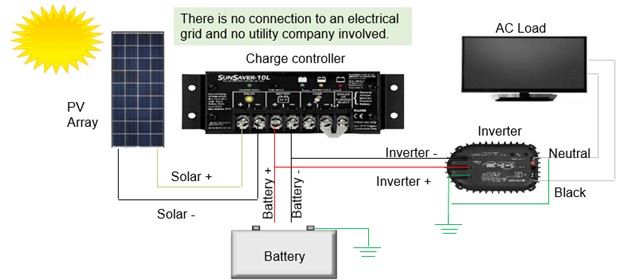
Source: Morningstar Corporation
These basic instructions are by no means complete. Unless you’re a professional electrician, it may be prudent to search out an expert for installation. Always better to be safe than sorry.
We recommend this article as a trustworthy resource to give you a good idea of all the electrical connections involved.
Key takeaways on the top solar panels for RV use
Whether you RV full-time, seasonally, or just on occasional weekends, locating an unoccupied electric hookup that works or topping off a fossil fuel-powered generator can be frustrating at best — disastrous at worst.
No one, especially boondockers, wants to be cold or hungry, especially when they’re far from their home’s creature comforts.
Take the guesswork out of energy — and put an eco-friendly spin on it at the same time — by considering solar panels for your recreational vehicle, caravan, camper, van, or trailer.
Also read:
After careful research, we’ve assembled here the ultimate list of the best RV solar panels.
We’ve also put together the ultimate go-to resource for finding and using the best RV solar panel kits.
Our buyer’s guide to RV solar panels and kits contains valuable information to keep in mind when purchasing a solar array for off-grid use. Included are detailed descriptions for each of the four major components of an RV solar system.
We hope you find lifestyle-changing value in this content on the best RV solar panels and kits whatever type of RVer you are: seasonal vacationer, die-hard nomad, or anyone in between. See you on the road!
